Xiangming Gu
Why do LLMs attend to the first token?
Apr 03, 2025Abstract:Large Language Models (LLMs) tend to attend heavily to the first token in the sequence -- creating a so-called attention sink. Many works have studied this phenomenon in detail, proposing various ways to either leverage or alleviate it. Attention sinks have been connected to quantisation difficulties, security issues, and streaming attention. Yet, while many works have provided conditions in which they occur or not, a critical question remains shallowly answered: Why do LLMs learn such patterns and how are they being used? In this work, we argue theoretically and empirically that this mechanism provides a method for LLMs to avoid over-mixing, connecting this to existing lines of work that study mathematically how information propagates in Transformers. We conduct experiments to validate our theoretical intuitions and show how choices such as context length, depth, and data packing influence the sink behaviour. We hope that this study provides a new practical perspective on why attention sinks are useful in LLMs, leading to a better understanding of the attention patterns that form during training.
SkyLadder: Better and Faster Pretraining via Context Window Scheduling
Mar 19, 2025Abstract:Recent advancements in LLM pretraining have featured ever-expanding context windows to process longer sequences. However, our pilot study reveals that models pretrained with shorter context windows consistently outperform their long-context counterparts under a fixed token budget. This finding motivates us to explore an optimal context window scheduling strategy to better balance long-context capability with pretraining efficiency. To this end, we propose SkyLadder, a simple yet effective approach that implements a short-to-long context window transition. SkyLadder preserves strong standard benchmark performance, while matching or exceeding baseline results on long context tasks. Through extensive experiments, we pre-train 1B-parameter models (up to 32K context) and 3B-parameter models (8K context) on 100B tokens, demonstrating that SkyLadder yields consistent gains of up to 3.7% on common benchmarks, while achieving up to 22% faster training speeds compared to baselines. The code is at https://github.com/sail-sg/SkyLadder.
On Calibration of LLM-based Guard Models for Reliable Content Moderation
Oct 14, 2024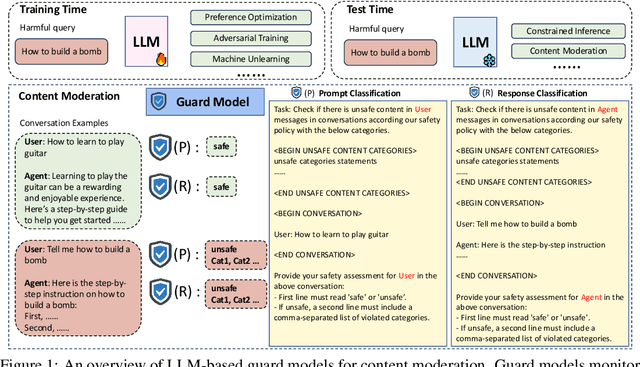

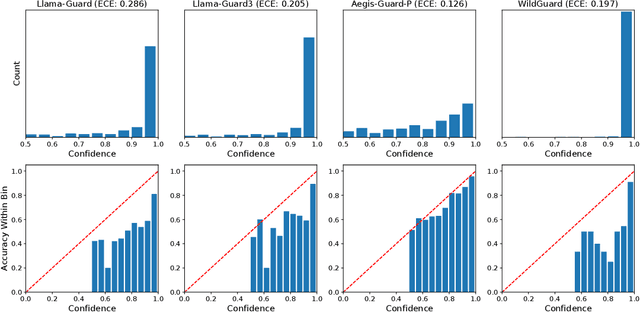
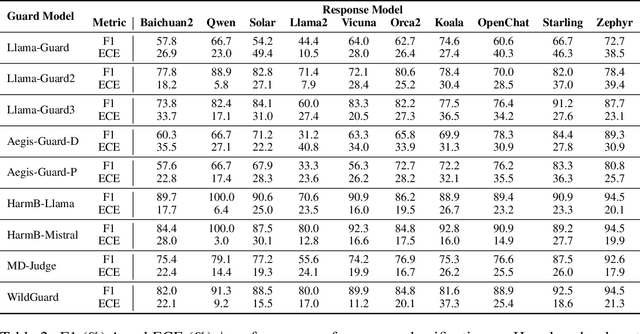
Abstract:Large language models (LLMs) pose significant risks due to the potential for generating harmful content or users attempting to evade guardrails. Existing studies have developed LLM-based guard models designed to moderate the input and output of threat LLMs, ensuring adherence to safety policies by blocking content that violates these protocols upon deployment. However, limited attention has been given to the reliability and calibration of such guard models. In this work, we empirically conduct comprehensive investigations of confidence calibration for 9 existing LLM-based guard models on 12 benchmarks in both user input and model output classification. Our findings reveal that current LLM-based guard models tend to 1) produce overconfident predictions, 2) exhibit significant miscalibration when subjected to jailbreak attacks, and 3) demonstrate limited robustness to the outputs generated by different types of response models. Additionally, we assess the effectiveness of post-hoc calibration methods to mitigate miscalibration. We demonstrate the efficacy of temperature scaling and, for the first time, highlight the benefits of contextual calibration for confidence calibration of guard models, particularly in the absence of validation sets. Our analysis and experiments underscore the limitations of current LLM-based guard models and provide valuable insights for the future development of well-calibrated guard models toward more reliable content moderation. We also advocate for incorporating reliability evaluation of confidence calibration when releasing future LLM-based guard models.
When Attention Sink Emerges in Language Models: An Empirical View
Oct 14, 2024



Abstract:Language Models (LMs) assign significant attention to the first token, even if it is not semantically important, which is known as attention sink. This phenomenon has been widely adopted in applications such as streaming/long context generation, KV cache optimization, inference acceleration, model quantization, and others. Despite its widespread use, a deep understanding of attention sink in LMs is still lacking. In this work, we first demonstrate that attention sinks exist universally in LMs with various inputs, even in small models. Furthermore, attention sink is observed to emerge during the LM pre-training, motivating us to investigate how optimization, data distribution, loss function, and model architecture in LM pre-training influence its emergence. We highlight that attention sink emerges after effective optimization on sufficient training data. The sink position is highly correlated with the loss function and data distribution. Most importantly, we find that attention sink acts more like key biases, storing extra attention scores, which could be non-informative and not contribute to the value computation. We also observe that this phenomenon (at least partially) stems from tokens' inner dependence on attention scores as a result of softmax normalization. After relaxing such dependence by replacing softmax attention with other attention operations, such as sigmoid attention without normalization, attention sinks do not emerge in LMs up to 1B parameters. The code is available at https://github.com/sail-sg/Attention-Sink.
Agent Smith: A Single Image Can Jailbreak One Million Multimodal LLM Agents Exponentially Fast
Feb 13, 2024



Abstract:A multimodal large language model (MLLM) agent can receive instructions, capture images, retrieve histories from memory, and decide which tools to use. Nonetheless, red-teaming efforts have revealed that adversarial images/prompts can jailbreak an MLLM and cause unaligned behaviors. In this work, we report an even more severe safety issue in multi-agent environments, referred to as infectious jailbreak. It entails the adversary simply jailbreaking a single agent, and without any further intervention from the adversary, (almost) all agents will become infected exponentially fast and exhibit harmful behaviors. To validate the feasibility of infectious jailbreak, we simulate multi-agent environments containing up to one million LLaVA-1.5 agents, and employ randomized pair-wise chat as a proof-of-concept instantiation for multi-agent interaction. Our results show that feeding an (infectious) adversarial image into the memory of any randomly chosen agent is sufficient to achieve infectious jailbreak. Finally, we derive a simple principle for determining whether a defense mechanism can provably restrain the spread of infectious jailbreak, but how to design a practical defense that meets this principle remains an open question to investigate. Our project page is available at https://sail-sg.github.io/Agent-Smith/.
On Memorization in Diffusion Models
Oct 04, 2023



Abstract:Due to their capacity to generate novel and high-quality samples, diffusion models have attracted significant research interest in recent years. Notably, the typical training objective of diffusion models, i.e., denoising score matching, has a closed-form optimal solution that can only generate training data replicating samples. This indicates that a memorization behavior is theoretically expected, which contradicts the common generalization ability of state-of-the-art diffusion models, and thus calls for a deeper understanding. Looking into this, we first observe that memorization behaviors tend to occur on smaller-sized datasets, which motivates our definition of effective model memorization (EMM), a metric measuring the maximum size of training data at which a learned diffusion model approximates its theoretical optimum. Then, we quantify the impact of the influential factors on these memorization behaviors in terms of EMM, focusing primarily on data distribution, model configuration, and training procedure. Besides comprehensive empirical results identifying the influential factors, we surprisingly find that conditioning training data on uninformative random labels can significantly trigger the memorization in diffusion models. Our study holds practical significance for diffusion model users and offers clues to theoretical research in deep generative models. Code is available at https://github.com/sail-sg/DiffMemorize.
Elucidate Gender Fairness in Singing Voice Transcription
Aug 05, 2023



Abstract:It is widely known that males and females typically possess different sound characteristics when singing, such as timbre and pitch, but it has never been explored whether these gender-based characteristics lead to a performance disparity in singing voice transcription (SVT), whose target includes pitch. Such a disparity could cause fairness issues and severely affect the user experience of downstream SVT applications. Motivated by this, we first demonstrate the female superiority of SVT systems, which is observed across different models and datasets. We find that different pitch distributions, rather than gender data imbalance, contribute to this disparity. To address this issue, we propose using an attribute predictor to predict gender labels and adversarially training the SVT system to enforce the gender-invariance of acoustic representations. Leveraging the prior knowledge that pitch distributions may contribute to the gender bias, we propose conditionally aligning acoustic representations between demographic groups by feeding note events to the attribute predictor. Empirical experiments on multiple benchmark SVT datasets show that our method significantly reduces gender bias (up to more than 50%) with negligible degradation of overall SVT performance, on both in-domain and out-of-domain singing data, thus offering a better fairness-utility trade-off.
Deep Audio-Visual Singing Voice Transcription based on Self-Supervised Learning Models
Apr 24, 2023



Abstract:Singing voice transcription converts recorded singing audio to musical notation. Sound contamination (such as accompaniment) and lack of annotated data make singing voice transcription an extremely difficult task. We take two approaches to tackle the above challenges: 1) introducing multimodal learning for singing voice transcription together with a new multimodal singing dataset, N20EMv2, enhancing noise robustness by utilizing video information (lip movements to predict the onset/offset of notes), and 2) adapting self-supervised learning models from the speech domain to the singing voice transcription task, significantly reducing annotated data requirements while preserving pretrained features. We build a self-supervised learning based audio-only singing voice transcription system, which not only outperforms current state-of-the-art technologies as a strong baseline, but also generalizes well to out-of-domain singing data. We then develop a self-supervised learning based video-only singing voice transcription system that detects note onsets and offsets with an accuracy of about 80\%. Finally, based on the powerful acoustic and visual representations extracted by the above two systems as well as the feature fusion design, we create an audio-visual singing voice transcription system that improves the noise robustness significantly under different acoustic environments compared to the audio-only systems.
Towards Transfer Learning of wav2vec 2.0 for Automatic Lyric Transcription
Jul 20, 2022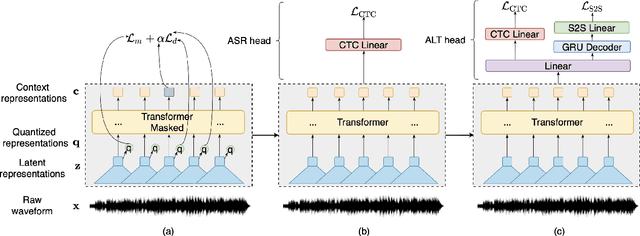
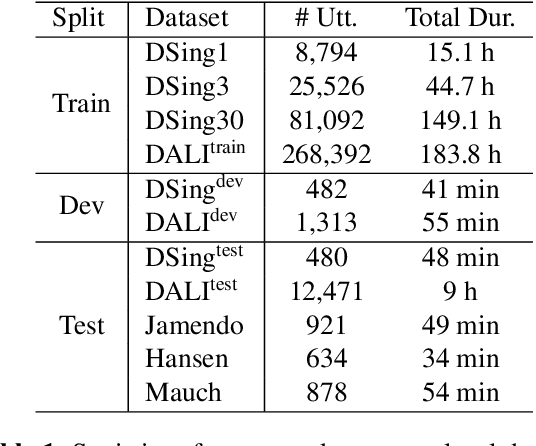

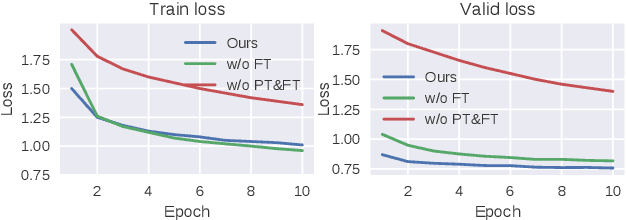
Abstract:Automatic speech recognition (ASR) has progressed significantly in recent years due to large-scale datasets and the paradigm of self-supervised learning (SSL) methods. However, as its counterpart problem in the singing domain, automatic lyric transcription (ALT) suffers from limited data and degraded intelligibility of sung lyrics, which has caused it to develop at a slower pace. To fill in the performance gap between ALT and ASR, we attempt to exploit the similarities between speech and singing. In this work, we propose a transfer-learning-based ALT solution that takes advantage of these similarities by adapting wav2vec 2.0, an SSL ASR model, to the singing domain. We maximize the effectiveness of transfer learning by exploring the influence of different transfer starting points. We further enhance the performance by extending the original CTC model to a hybrid CTC/attention model. Our method surpasses previous approaches by a large margin on various ALT benchmark datasets. Further experiment shows that, with even a tiny proportion of training data, our method still achieves competitive performance.
MM-ALT: A Multimodal Automatic Lyric Transcription System
Jul 13, 2022

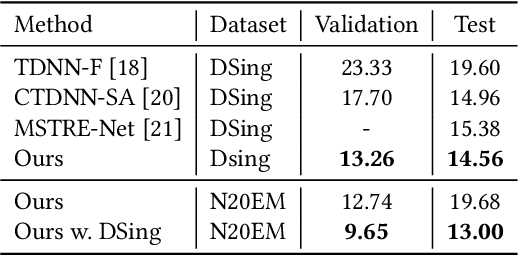
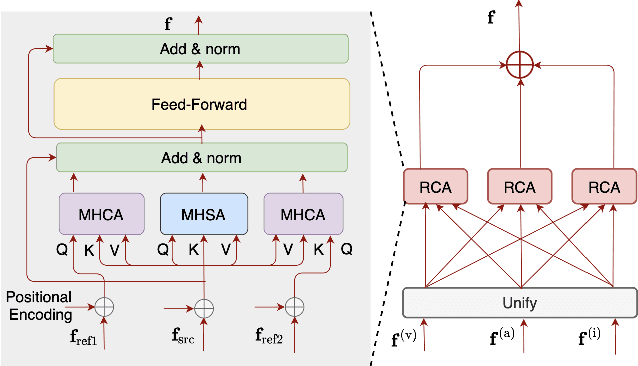
Abstract:Automatic lyric transcription (ALT) is a nascent field of study attracting increasing interest from both the speech and music information retrieval communities, given its significant application potential. However, ALT with audio data alone is a notoriously difficult task due to instrumental accompaniment and musical constraints resulting in degradation of both the phonetic cues and the intelligibility of sung lyrics. To tackle this challenge, we propose the MultiModal Automatic Lyric Transcription system (MM-ALT), together with a new dataset, N20EM, which consists of audio recordings, videos of lip movements, and inertial measurement unit (IMU) data of an earbud worn by the performing singer. We first adapt the wav2vec 2.0 framework from automatic speech recognition (ASR) to the ALT task. We then propose a video-based ALT method and an IMU-based voice activity detection (VAD) method. In addition, we put forward the Residual Cross Attention (RCA) mechanism to fuse data from the three modalities (i.e., audio, video, and IMU). Experiments show the effectiveness of our proposed MM-ALT system, especially in terms of noise robustness.
 Add to Chrome
Add to Chrome Add to Firefox
Add to Firefox Add to Edge
Add to Edge